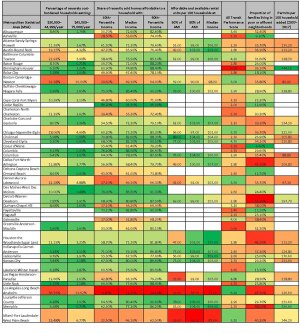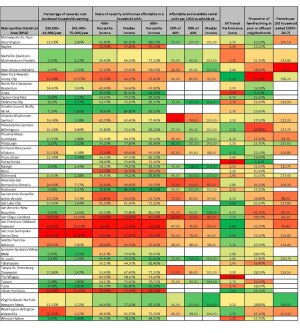Attainable housing and income segregation remain major challenges for families and communities.
The ULI Terwilliger Center for Housing has created a Home Attainability Index, designed to support ULI district councils, local municipalities, and members of the development community who are working to address longstanding challenges related to home affordability.
The resources in the index provide a high-level snapshot of the extent to which a region’s housing market offers a range of attainable choices to the local workforce. The information in this index will help identify gaps in home attainability and provide a better context for understanding residential markets. Over time, the index will enable national and regional comparisons to inform decisions about housing production, policy, and financing. The index, which is in the pilot stage, was debuted at the ULI Housing Opportunity Conference held during February in Miami. (Readers should note that these resources were developed and released before the widespread outbreak of COVID-19 in the United States, and therefore do not capture housing challenges resulting from the associated economic disruption.)
To develop the index, the ULI Terwilliger Center selected 11 metrics from existing, nationally recognized data sources and providers, including the U.S. Census Bureau, the Harvard Joint Center for Housing Studies, the National Housing Conference (NHC), and the National Low Income Housing Coalition. The index metrics fit into five core categories: overall affordability, homeownership attainability, rental attainability, neighborhood opportunity and access, and housing production. In addition, the Terwilliger Center partnered with the NHC to contextualize home attainability data with regional needs for workforce housing.
As part of the suite of index-related resources, the Terwilliger Center released a national summary report, which found that even though some observers had recently noted an easing in home affordability challenges in some locations, problems remain.
- Attainability gaps continue to be observed around the United States, even though severe cost burdens among middle-income households tend to be concentrated in high-cost metropolitan areas;
- The income premium that workers enjoy in high-cost areas is often overwhelmed by dramatically higher housing costs;
- Lower-income workers face more universal struggles finding rental housing that they can afford; and
- Residential income segregation remains deeply embedded throughout the country, threatening long-term health, education, economic, and other outcomes for lower-income residents and the communities in which they live.
When one looks more closely at individual regions, five stand out as promising performers, with index values that were average or better across all indicators:
- Buffalo-Cheektowaga-Niagara Falls, New York;
- Ogden-Clearfield, Utah;
- Pittsburgh, Pennsylvania;
- Provo-Orem, Utah; and
- Virginia Beach-Norfolk-Newport News, Virginia.
The Minneapolis-St. Paul-Bloomington metropolitan area receives an honorable mention for achieving better-than-average rankings across all categories except housing production.
These regions are notable for two reasons. First, both rental and homeownership options are broadly attainable, while still performing well on indicators of neighborhood opportunity and access. In addition, the regions indicate that broad attainability is possible in various contexts, with the six regions representing a range of geographies.
In the coming months, the Terwilliger Center will publish a series of data Dashboards for each of the Institute’s 50 U.S.-based district councils, which will be made available through ULI’s Knowledge Finder, knowledge.uli.org/TCindex. These Dashboards will create a snapshot of select housing conditions in the metro areas served by each council, including an overview of index measures, national comparisons, and supplemental metrics to provide context to those measures included in the index.
Each Dashboard includes an Occupational Analysis using Paycheck-to-Paycheck data provided by the NHC, which can be found at https://www.nhc.org/paycheck-to-paycheck/. Paycheck-to-Paycheck compares regional median incomes for 81 occupations with the cost to purchase or rent homes in 259 metropolitan regions across the United States. The Home Attainability Index’s Occupational Analysis involved selecting a sample of occupations for comparison across the regions in which ULI members are active. For these occupations, we calculated the attainability gap (i.e., the additional amount the household would need to earn to afford a given type of housing) or surplus to compare attainability across regions.
The Paycheck-to-Paycheck data are also used to create “occupational benchmarks” for select index metrics that were tied to specific income thresholds (such as median incomes or income percentiles). For example, one index metric is the number of rental units affordable and available at 80 percent of the region’s median income. The occupational benchmarks illustrate that in the Denver region, a loan officer earning approximately $76,000 per year would be at that income level, while in Detroit it would be characterized by an HVAC mechanic earning approximately $62,000.
As the United States fights the COVID-19 pandemic, it is important to note that many essential members of the workforce struggle to find homes, even in the best of times. A delivery truck driver cannot afford a modest one-bedroom apartment in 17 of the 79 regions included in the Occupational Analysis, and can afford to purchase a median-priced home in only three. A retail salesperson (which can include some grocery-store workers) can afford a one-bedroom rental in only 19 regions, and homeownership in none.
The crisis exacerbates these households’ challenges, since they are unlikely to be able to work from home, may not have the option of taking sick leave, or may be balancing work with additional child care responsibilities given the widespread closures of schools and daycare facilities. While the impacts of the pandemic and the resulting economic disruption will not be known for some time, the data demonstrate the need for housing market and policy reforms to serve the full breadth of the regional workforce.
In addition to publishing the full complement of district council Dashboards, moving forward the Terwilliger Center will work to update and improve the suite of Home Attainability Index resources on an annual basis. To ensure that this effort provides value to its users, the center welcomes feedback on potential improvements and opportunities to incorporate information relevant to practitioners in the field. To access the latest resources, visit: knowledge.uli.org/TCindex. Feedback can be offered by contacting Michael Spotts, ULI visiting research fellow, at [email protected].
MICHAEL A. SPOTTS is a visiting research fellow with the ULI Terwilliger Center for Housing. He has over a decade of experience conducting applied policy research activities focused on housing affordability and community development.






